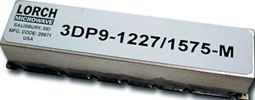

The global positioning system (GPS) refers to a group of satellites constantly circling the earth. These satellites transmit very low power radio signals, allowing anyone with a GPS receiver to determine their current location. Each satellite transmits on several frequencies designated as L1, L2, etc. The signals travel 'line-of-sight' meaning they will pass through clouds, glass and plastic, but will not go through most solid objects such as buildings and mountains. These line-of-sight signals are also susceptible to other interfering signals, such as the US ATC Radar.
Lorch Microwave has developed a filter to provide the telecoms industry with an off-the-shelf product that addresses the ever-increasing frequency interference problem with today's crowded frequency spectrum.
GPS diplexer
Lorch's 3DP9-1227/1575-M is a surface mount GPS diplexer that has been designed to provide excellent in-band performance while achieving superior out of band attenuation in a small mechanical configuration. Insertion loss is typically the most important design concern, as it directly affects the overall system noise figure. A 0,01 dB ripple Chebychev transfer function was chosen to provide minimum insertion loss and maximum out-of-band attenuation. The passband bandwidth is specified as 0,5 dB flatness minimum over 30 MHz. A three pole filter response was chosen to provide adequate attenuation and minimum size. The typical performance for the 3DP9-1227/1575-M is shown in the graph in Figure 1.

The lower band of the diplexer is centred on 1227,6 MHz. The insertion loss at mid band is 1,3 dB typical and specified as 1,5 dB maximum over temperature. The 3 dB bandwidth is 100 MHz nominal. The pass band, as previously stated, is 0,5 dB relative over the centre 30 MHz (1212 to 1242). The return loss is 14 dB minimum and 17 dB typical over the centre 30 MHz of the band.
In looking at the graph in Figure 2, the upper band of the diplexer is centred on 1575,42 MHz. The insertion loss at mid-band is 1,3 dB typical and specified as 1,5 dB maximum over temperature. The 3 dB bandwidth is 100 MHz nominal. The pass band on the upper channel is also 0,5 dB relative over the centre 30 MHz (1560 to 1590). The return loss is 14 dB minimum and 17 dB typical over the centre 30 MHz of the band. Isolation between the two channels is typically greater than 25 dB.

Package
The filter is packaged on an open-framed FR4 carrier PCB, 32 mm long by 13 mm wide. The overall height of the package is 10 mm. Lorch uses an electro-less nickel gold plate on its carrier boards for ease of solder, and builds its components with s/n 96 solder to withstand reflow conditions of 215°C for 15 seconds. The filter is suitable for various applications, both military and commerical. This filter is designed in a surface mount configuration, however, Lorch can make it in a variety of other custom packages with SMA or miniature connector configurations, including in an hermetically-sealed housing if the environmental conditions warrant it.
Lorch has tested the filters at -40, +25, and +70°C, and the typical temperature drift has been measured at less than 10 ppm/°C over the frequency and bandwidth.
The 3DP9-1227/1575-M diplexer has also been used as filtering for LNA (low noise amplifiers). By taking the diplexer and combining this unit with an LNA, one is able to provide a GPS preamplifier with different gain variations as well as selectivity. The filter has very little effect on the system overall noise figure due to the low mid-band insertion loss. Lorch also has other standard designs available that provide more selectivity with a slight increase in package size and insertion loss.
| Tel: | +27 21 555 8400 |
| Email: | [email protected] |
| www: | www.rfdesign.co.za |
| Articles: | More information and articles about RF Design |

© Technews Publishing (Pty) Ltd | All Rights Reserved